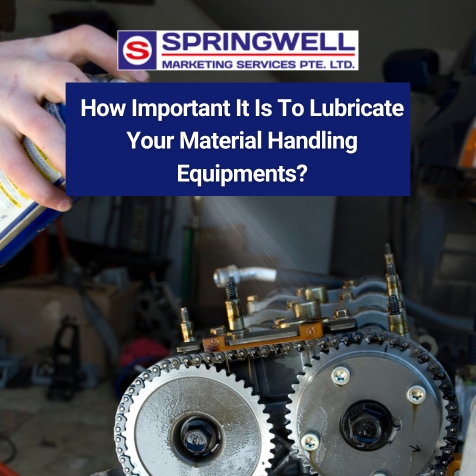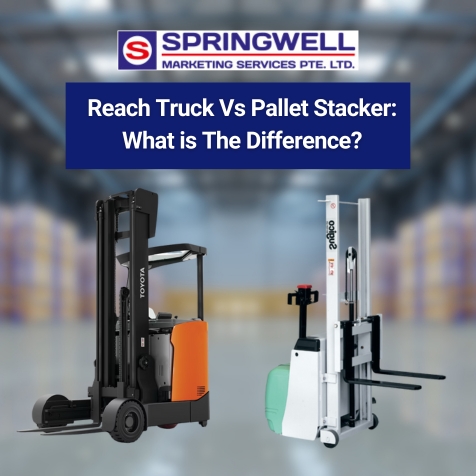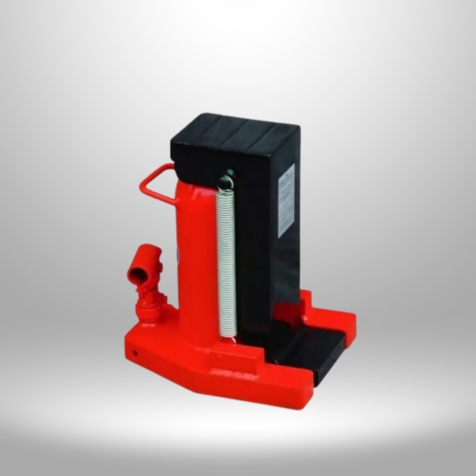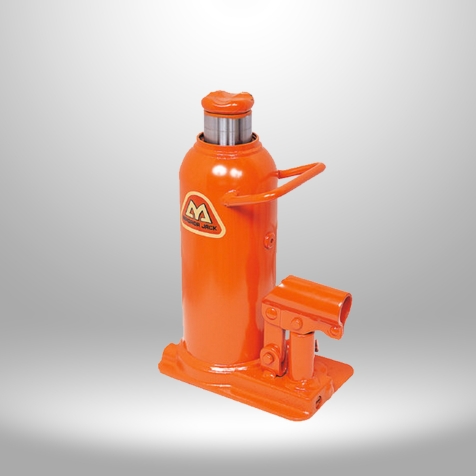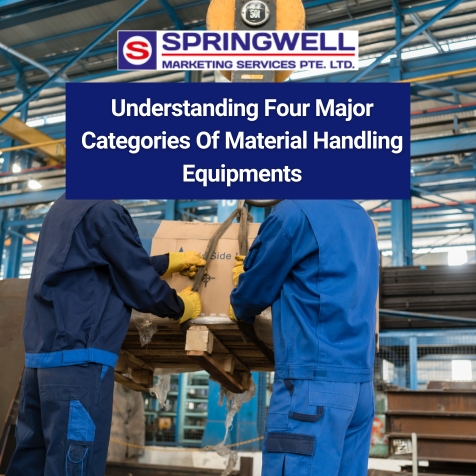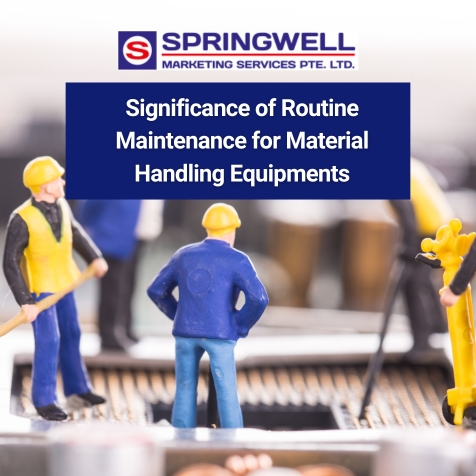
How Important It Is To Lubricate Your Material Handling Equipments?
Material handling equipments are a crucial part of any industry or manufacturing facility.
These equipments play a vital role in the smooth functioning and productivity of various operations. From lifting heavy objects to transporting goods, material handling equipment has made tasks easier, faster and more efficient.
One important aspect of maintaining these equipments is regular lubrication. It involves applying a lubricant to the moving parts of the equipment to reduce friction and wear, thus increasing its lifespan and performance.
Today, we will discuss the importance of oil-lubricating your material handling equipment and how it can benefit your business.
Reasons To Regularly Lubricate Material Handling Equipments
Regular lubrication is vital for the smooth functioning and longevity of material handling equipment. Here are some reasons why you should make it a priority in your maintenance routine:
a) Prevents Wear And Tear
Material handling equipments are constantly exposed to heavy loads and repetitive movements, which can cause friction between the moving parts. This friction can lead to wear and tear, resulting in costly repairs or replacements.
By regularly lubricating your equipment, you reduce the amount of friction between the parts, thus prolonging their lifespan.
b) Reduces Maintenance Costs
As mentioned earlier, regular lubrication helps prevent wear and tear on material handling equipments.
This not only extends their lifespan, but also reduces the need for frequent maintenance and repairs. This ultimately saves your business money by minimising downtime and costly repairs.
c) Improves Performance
Well-lubricated equipment operates more smoothly and efficiently, leading to improved performance. This is especially important in material handling operations, where time and speed are critical factors.
By regularly lubricating your equipment, you can maintain its optimal functioning and ensure that it performs at its best.
d) Prevents Accidents
Neglecting to lubricate your material handling equipment can lead to malfunctions or breakdowns that can potentially cause accidents in the workplace.
Regular lubrication helps keep your equipment in good working condition and reduces the risk of accidents, ensuring a safe working environment for employees.
What Equipment to Lubricate?
As mentioned earlier, lubricating your equipment is important for its proper functioning and longevity. However, it can be overwhelming to determine which parts of your equipment need to be lubricated. Here are some common types of equipment that require regular oil lubrication:
- Forklifts:
- Conveyor systems
- Cranes
- Hoists
- Pallet jacks
- Automated guided vehicles (AGVs)
- Scissor lifts
It’s crucial to refer to your manufacturer’s manual for specific instructions on where and how often each part of the equipment should be lubricated.
Types of Lubricants
There are various types of lubricants that can be used for equipment maintenance. The most common types include:
- Oil-based lubricants: These are the most commonly used type of lubricant, and can range from mineral oils to synthetic oils.
- Grease: This type of lubricant is typically made up of oil and a thickening agent, such as lithium or calcium, which helps it stick to surfaces longer.
- Dry lubricants: These are usually in powdered form and are best used for high temperature applications where other types of lubricants may not work as effectively.
It’s important to choose the right type of lubricant for your equipment based on factors such as temperature, load capacity, and environment. Using the wrong type of lubricant can lead to equipment failure and costly repairs.
Factors to Consider
When selecting a lubricant, it’s essential to consider the following factors:
- Temperature: The operating temperature of your equipment is a crucial factor in determining the type of lubricant you should use. Some lubricants may break down or become less effective under high temperatures, while others are specifically designed for extreme temperature conditions.
- Load capacity: The amount of pressure and weight your equipment handles also plays a role in choosing the right lubricant. Heavy machinery with high load capacities will require a more robust and durable lubricant to withstand the stress placed on it.
- Environment: Different environments, such as wet or dusty conditions, can affect the performance of lubricants. For example, if you’re working in a wet environment, you may need to use a water-resistant lubricant to prevent it from washing away.
- Compatibility: It’s essential to consider the compatibility of your chosen lubricant with your equipment and other components. Using an incompatible lubricant can cause damage and reduce its effectiveness.
Takeaway
Choosing the right lubricant is crucial for maintaining and prolonging the life of your material handling equipment.
Consider factors such as viscosity, base oil type, additives, operating conditions, and compatibility when selecting a lubricant. Regularly check and monitor its performance to ensure adequate protection.
By selecting and using the right lubricant, you can save time and money in the long run by preventing costly equipment repairs or replacements.
Both reach trucks and pallet stackers are popular types of forklifts used in the warehousing industry. They both have their unique features and benefits, making them essential equipment for material handling operations. However, many people often confuse the two machines and use the terms interchangeably.
Today, we will discuss the key differences between reach trucks and pallet stackers to help you understand which one is suitable for your business needs.
Definition
Before diving into the comparison between reach trucks and pallet stackers, let’s first define each machine to avoid any confusion.
Reach Truck
A reach truck is a type of forklift that is specifically designed for narrow aisle and high-rack operations. It is equipped with extendable forks that can reach up to 40 feet in height, allowing it to access tight spaces and lift pallets from racking systems.
Pallet Stacker
On the other hand, a pallet stacker is also a type of forklift that is primarily used for lifting and stacking pallets in warehouses. Unlike reach trucks, pallet stackers have a more compact design and are suitable for low-rack operations.
Key Differences
Now that we have defined both machines, let’s take a closer look at their key differences:
a) Functionality
The main difference between a reach truck and a pallet stacker lies in their functionality.
Reach trucks are designed for horizontal transportation and vertical lifting of loads, whereas pallet stackers are solely used for stacking and retrieving pallets.
b) Size and Maneuverability
Reach trucks have a more significant size compared to pallet stackers due to their extended reach capabilities. This makes them ideal for bulky or heavy loads that require stability during transport.
Pallet stackers, on the other hand, have a more compact design and are better suited for narrow aisles and tight spaces.
c) Lifting Capacity
Due to their smaller size, pallet stackers typically have a lower lifting capacity compared to reach trucks.
Pallet stackers can typically lift loads up to 5,500 pounds, while reach trucks can handle loads up to 4,000 pounds or more.
d) Lift Height
One significant difference between reach trucks and pallet stackers is their maximum lift height.
Reach trucks have a higher lift height due to their extended mast and telescoping forks, allowing them to access racks at greater heights. Pallet stackers have a limited lift height, making them better suited for ground-level stacking and retrieving tasks.
e) Cost-effectiveness
Reach truck and pallet stacker are both cost-effective options for material handling, but pallet stackers tend to be more budget-friendly due to their simpler design and lower lift height capabilities.
Reach trucks may have a higher upfront cost, but their ability to reach greater heights can result in faster and more efficient operations, thus providing long-term cost savings.
When To Use Reach Truck Vs Pallet Stacker
The decision to use a reach truck or pallet stacker ultimately depends on the specific material handling needs of your operation. To help you make an informed decision, consider the following factors:
1) Warehouse Space and Layout
When it comes to warehouse space and layout, pallet stackers are more suitable for smaller spaces with narrow aisles due to their compact design and ability to manoeuver in tight spaces. Reach trucks, on the other hand, require wider aisles, but can operate in larger spaces.
2) Lift Height Requirements
As mentioned earlier, reach trucks have greater lift height capabilities compared to pallet stackers. If your warehouse has high racking systems or requires frequent stacking and retrieval of goods at higher levels, a reach truck would be the more suitable choice.
3) Load Capacity
Pallet stackers are ideal for lighter loads, usually up to 2,500 pounds. Reach trucks, on the other hand, have a higher load capacity and can handle heavier loads up to 4,500 pounds or more depending on the model.
If your warehouse deals with heavy pallets or stacks multiple pallets at once, a reach truck would be the better option.
Takeaway
When deciding between a pallet stacker and a reach truck, it’s important to consider the specific needs and requirements of your warehouse operations.
For basic stacking and retrieval tasks with lighter loads, a pallet stacker would suffice. However, if your warehouse deals with heavier loads or requires more precise handling at higher levels, a reach truck would be the more suitable choice.
Ultimately, choosing the right equipment will help improve efficiency and productivity in your warehouse. So always carefully assess your requirements before making a decision.
Springwell For Material Handling Equipments
Springwell is a leading provider of material handling equipment, offering a wide range of products to suit various industries and applications. Their equipment is designed for maximum efficiency, durability, and safety in the workplace.
Contact us today to learn more about our products and services!
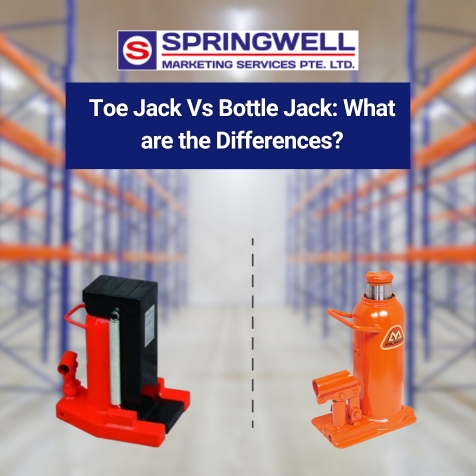
When it comes to lifting and supporting heavy objects, jacks are essential tools that can make the job much easier. However, with so many types of jacks available on the market, it can be confusing to know which one is best for your specific needs.
Two popular types of jacks are toe jacks and bottle jacks. They may look similar at first glance, but they have distinct differences that set them apart from each other.
Today, we will explore what these differences are and when you should use one over the other.
What is a Toe Jack?
A toe jack is a specialised type of hydraulic jack that is designed specifically for lifting heavy loads in tight spaces. It gets its name from the small, pointed toe at the bottom of the jack, which is used to fit into narrow gaps or grooves.
Toe jacks come in various sizes and weight capacities, with some models capable of lifting up to 50 tons. They are commonly used in industrial settings for tasks such as machinery rigging, heavy equipment maintenance and installation, and construction projects.
What is a Bottle Jack?
Bottle jacks, also known as hydraulic bottle jacks or hand jacks, are another type of hydraulic jack that is commonly used for lifting heavy objects. As their name suggests, they have a cylindrical shape similar to that of a bottle.
These jacks have a flat base and a long neck with a large piston that extends out when the jack is in use. They come in various capacities, ranging from 2 tons up to 50 tons, and are often used in automotive and construction industries.
Differences Between Toe Jacks and Bottle Jacks
While toe jacks and bottle jacks may seem similar on the surface, they have several key differences that make them suitable for different purposes. Let’s take a closer look at these differences:
a) Design and Size
Toe jacks have a more compact design compared to bottle jacks. They are typically smaller in size and can fit into tight spaces, making them ideal for lifting heavy objects in confined areas.
On the other hand, bottle jacks have a bulkier design due to their cylindrical shape. While they may not be as versatile as toe jacks, they can handle heavier loads and offer more stability when used on flat surfaces.
b) Lifting Capacity
Due to their different designs, toe jacks and bottle jacks also differ in terms of their lifting capacities. As mentioned earlier, toe jacks come in various weight capacities ranging from 2 tons up to 50 tons.
In contrast, bottle jacks have a lower lifting capacity and are typically used for objects weighing up to 20 tons.
c) Range of Motion
Another significant difference between toe jacks and bottle jacks is their range of motion. Toe jacks have a limited vertical range, as they are only designed to lift objects off the ground. However, they offer more horizontal movement capabilities, making them useful for positioning heavy loads in tight spaces.
Bottle jacks, on the other hand, have a higher vertical range and can be extended much further than toe jacks. This makes them ideal for lifting heavier objects to greater heights.
When to Use Toe Jacks vs Bottle Jacks
Now that we understand the differences between these two types of jacks, when should you use one over the other? Here are a few scenarios where toe jacks and bottle jacks excel:
Use Toe Jacks When:
-
- Lifting heavy loads in tight spaces
- Positioning heavy objects horizontally
- Working with objects up to 50 tons in weight
Use Bottle Jacks When:
-
- Lifting heavier objects (up to 20 tons)
- Needing more stability on flat surfaces
- Requiring greater vertical range for lifting tasks
Are The Two Jacks Interchangeable?
While both toe jacks and bottle jacks have their unique strengths, they are not entirely interchangeable. Each jack is designed for a specific purpose, and trying to use one in place of the other may lead to safety hazards or damage to the jack.
It’s essential to understand the differences between toe jacks and bottle jacks, and use them accordingly for optimal results.
Takeaway
In summary, toe jacks and bottle jacks are both types of hydraulic jacks, but they have distinct differences that set them apart. Toe jacks are designed for lifting heavy objects in confined spaces, while bottle jacks offer more stability and higher lifting capacities on flat surfaces.
When deciding which jack to use for a specific task, consider the characteristics of each one and choose accordingly. By using the right type of jack for the job, you can ensure safety and efficiency in your lifting tasks.
Springwell For Material Handling Equipment
At Springwell, we offer a wide range of material handling equipment, including both toe jack and bottle jack. Our high-quality jacks are suitable for various industrial applications and can help you lift heavy objects with ease.
To learn more about our products and services, please visit our website or contact us today. Let us help you find the right jack for your specific needs!
When it comes to material handling, there are various types of equipment that are used in different industries and applications. These equipments play a crucial role in the efficient movement, storage, and control of materials within a manufacturing or distribution facility.
Today, we will discuss the four major categories of material handling equipment: storage and handling equipment, industrial trucks, bulk material handling equipment, and engineered systems.
Why Should You Understand The Different Categories Of Material Handling Equipments?
Understanding the different categories of material handling equipment is essential for several reasons:
- It helps select the right equipment for your specific application or industry.
- It ensures safe and efficient material handling operations.
- It increases productivity and reduces downtime.
- It minimises damage to materials and products during handling.
- It improves operational efficiency and cost-effectiveness.
Category 1: Storage And Handling Equipment
Storage and handling equipment are used for storing, organising, and transporting materials within a facility. These include pallet racks, shelving systems, bins, drawers, carts, conveyors, and automated storage and retrieval systems (AS/RS).
- Pallet racks and shelving systems are the most common type of storage equipment. They provide vertical storage space, making it easier to store and retrieve materials. Bins, drawers, and carts are used for smaller items and can be easily moved around the facility.
- Conveyors are used to transport materials from one location to another within a facility. They come in various types, such as roller, belt, chain, and skate-wheel conveyors.
- Automated storage and retrieval systems (AS/RS) are computer-controlled systems that automatically store, retrieve, and sort materials. They are often used in large-scale warehouses for efficient storage and retrieval of materials.
Category 2: Industrial Trucks
Industrial trucks are motorised vehicles that are used for lifting, moving, and transporting materials within a facility. These include forklifts, pallet jacks, reach trucks, and order pickers.
- Forklifts are the most common industrial truck used for lifting and transporting materials. They come in various sizes and can handle different weights and load types.
- Pallet jacks are used for moving pallets within a warehouse or storage facility. They are smaller than forklifts, but can only move horizontally.
- Reach trucks and order pickers are used for retrieving materials from high shelves or racking systems. They have extending arms that allow them to reach higher levels.
Category 3: Bulk Material Handling Equipment
Bulk material handling equipment is used for moving large quantities of materials, such as grains, minerals, chemicals, or liquids. These include conveyor belts, bucket elevators, stackers, and reclaimers.
- Conveyor belts are the most common type of bulk material handling equipment. They are used for transporting materials in a continuous stream along a specified path.
- Bucket elevators are used for vertically lifting or lowering materials in bulk quantities. They consist of buckets attached to a revolving belt or chain.
- Stackers and reclaimers are used for stockpiling and reclaiming large quantities of materials. They can store materials in organised piles and retrieve them when needed.
Category 4: Engineered Systems
Engineered systems are customised solutions that combine various types of material handling equipment to handle specific tasks or processes within a facility. These can include automated assembly lines, robots, and material handling integrated systems.
- Automated assembly lines use a combination of conveyors, robots, and other machinery to automate production processes. They are used for high-volume production and reduce the need for manual labour.
- Robots are used in material handling applications that require precision and efficiency. They can perform tasks such as picking up and placing items, sorting materials, or stacking pallets.
- Material handling integrated systems combine various types of equipment to create a streamlined process for moving materials within a facility. They can include conveyor systems, robotic arms, and automated storage systems.
What Are The Common Considerations When Choosing Material Handling Equipment?
When choosing material handling equipment, there are several factors to consider, including:
- The type of materials being handled (size, weight, shape)
- The layout and size of the facility
- The required speed and efficiency of material handling operations
- The safety features and regulations for the specific industry or application
- Any special requirements or processes that need to be accommodated.
Understanding these considerations can help you select the right equipment for your specific needs and ensure safe and efficient material handling operations.
Takeaway
Material handling equipment plays a crucial role in the efficient and safe movement, storage, and control of materials within a facility.
By understanding the different categories of equipment and their uses, you can make informed decisions when selecting equipment for your specific applications.
Consider factors such as materials being handled, facility layout, and safety regulations to choose the most suitable equipment for your operations.
Springwell, Your Choice For Material Handling Equipment
At Springwell, we offer a wide range of material handling equipment to meet your specific needs.
From storage and handling equipment to industrial trucks, we have the expertise and experience to provide customised solutions for your facility.
Contact us today to learn more about our products and services, and see how we can help optimise your material handling operations.
Routine maintenance is an essential aspect of material handling equipment (MHE) management. It involves regularly scheduled inspections, repairs, and replacements to ensure the safe and efficient operation of MHE.
Proper maintenance of these equipment not only ensures a longer lifespan, but also avoids costly breakdowns and accidents.
Importance of Routine Maintenance
Regular maintenance plays a crucial role in keeping MHE running smoothly. Here are some reasons why routine maintenance is significant for material handling equipment:
1) Ensures Safety
Safety should be a top priority when it comes to managing MHE. Routine maintenance helps to identify and resolve potential safety hazards before they become serious issues.
This includes checking for worn-out parts, loose bolts, and other potential risks that could cause accidents.
2) Increases Equipment Lifespan
MHE is a significant investment for any business. Regular maintenance ensures that the equipment is functioning at their optimal level, reducing the chances of breakdowns and extending their lifespan.
It also helps to detect problems early on before they lead to major breakdowns that can be costly to repair or replace.
3) Improves Efficiency
Properly maintained MHE operates more efficiently, resulting in increased productivity and reduced downtime.
Routine maintenance allows for adjustments and repairs to be made, ensuring that the equipment is functioning at their best. This also leads to cost savings, as well-maintained equipments require less fuel, energy, and labour to operate.
4) Compliance with Regulations
Certain industries have strict regulations and standards when it comes to equipment safety.
Regular maintenance helps ensure that MHE complies with these regulations, avoiding potential legal issues or fines.
Types of Routine Maintenance
There are several types of routine maintenance that should be performed on a regular basis:
1) Inspections
Regular inspections involve visually examining the equipment for any signs of wear and tear, leaks, or damage that could affect its performance or safety. This could include checking for cracks, corrosion, loose connections, or other physical issues.
Inspections can also include testing the equipment’s performance and functionality to ensure it operates as expected under normal conditions. This process helps identify potential problems early, prevent costly repairs or breakdowns, and ensures the equipment remains reliable and safe to use.
2) Lubrication
Proper lubrication is crucial for material handling equipment (MHE) to operate efficiently and reliably.
By lubricating moving parts, friction and wear are significantly reduced, ensuring smoother operation and minimising the risk of damage. This not only prevents unexpected breakdowns that can lead to costly downtime, but also extends the overall lifespan of the equipment
3) Cleaning
Keeping material handling equipment clean is essential for maintaining a safe and efficient working environment. Regular cleaning helps prevent dirt, debris, and grease buildup, which can damage critical parts, reduce the equipment’s lifespan, or even lead to costly repairs.
A clean machine also operates more reliably, ensuring consistent performance and minimising the risk of accidents caused by malfunction or reduced visibility.
4) Replacements/Repairs
Routine maintenance may also involve replacing worn-out parts or making repairs to damaged components, such as fixing broken seals, tightening loose connections, or addressing minor cracks in the structure.
These tasks are essential to prevent further deterioration and ensure that the equipment continues to operate safely, efficiently, and without unexpected interruptions.
Takeaway
Routine maintenance is crucial for ensuring the safe and efficient operation of material handling equipments. It not only increases their lifespan, but also improves safety, efficiency, and compliance with regulations.
Businesses that prioritise routine maintenance will reap the benefits in terms of cost savings and increased productivity. Therefore, it is important to have a comprehensive maintenance plan in place and follow it regularly.
Springwell For Material Handling Equipment
At Springwell, we provide various material handling equipment with top-notch quality and reliability.
Contact us today to learn more about our products and services! Keep your material handling equipment well-maintained for optimal performance and safety.


